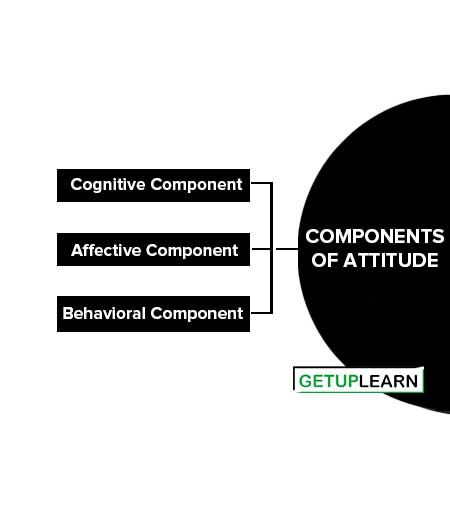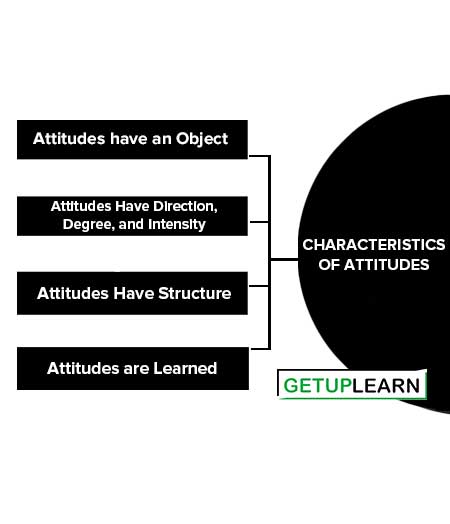Table of Contents
Meaning of Attitude
Attitude is a relatively permanent organizing or cognitive, perceptual, emotional, and motivational process with respect to some aspect of our environment. It is primarily a learned predisposition to respond in a consistently favorable or unfavorable manner with respect to a given object.
Thus, an attitude is the way we think, feel, and act toward some aspect of our environment. An attitude may be defined as a tendency to react positively or negatively in regard to an object. Attitudes are evaluative statements or judgments- either favorable or unfavorable concerning objects, people, or events.
Definition of Attitude
Attitudes are likes and dislikes.
Bern
Attitudes are an overall evaluation that allows one to respond in a consistently favourable or unfavourable manner with respect to a given object or alternative.
Engel
Attitude is “learned predispositions to respond to an object or class of object in a consistently favourable or unfavourable way.
Allport
A definition of attitude popularized by cognitively oriented social psychologists is, “an enduring organization of motivational, emotional, perceptual and cognitive process with respect to some aspect of the individual’s world.
Components of Attitude
According to the above views, the following are three components of attitude:

Cognitive Component
This component includes the beliefs an individual has about a certain person, object, or situation. The belief that “discrimination is wrong” is a value statement. Such an opinion is the cognitive component of an attitude. Learned beliefs, such as “you need to work long hours to get ahead in this job”, lead to attitudes that have an impact on behavior in the workplace.
The cognition component of an attitude reflects a person’s perceptions or beliefs. Cognitive elements are evaluative beliefs and are measured by attitude scales or by asking about thoughts. The statement “I believe Japanese workers are industrious,” reflects the cognitive component of an attitude. The cognitive component sets the stage for the more critical part of attitude- its affective component.
Affective Component
This component refers to the person’s feelings that result from his or her beliefs about a person, object, or situation. A person who believes that hard work earns promotions may feel anger or frustration when he or she works hard but is not promoted.
The affective component becomes stronger as an individual has more frequent and direct experience with a focal object, person, or situation. ‘Affect’ is the emotional component of an attitude. It refers to an individual’s feelings about something or someone.
Statements such as “I like this” or “I prefer that” reflect the affective component of an attitude. Affect is measured by physiological indicators such as galvanic skin response (changes in electrical resistance of skin which indicate emotional arousal) and blood pressure.
These indicators show changes in emotions by measuring physiological arousal. If an individual is trying to hide his or her feelings, this might be shown by a change in arousal.
Behavioral Component
This component refers to the individual’s behavior that occurs as a result of his or her feelings about the focal person, object, or situation. An individual may complain, request a transfer, or be less productive because he or she feels dissatisfied with work.
The behavioral component of an attitude refers to an intention to behave in a certain way toward someone or something. The behavioral component is the intention to behave in a certain way towards an object or person.
For example, our attitudes towards women in management may be inferred from an observation of the way we behave toward a female supervisor. We may be supportive, passive, or hostile depending on our attitude. The behavioral component of an attitude is measured by observing behavior or by asking a person about behavior or intentions.
Importance of Employee Attitude
These are the importance of employee attitude:
- Employee attitudes are important to organizations. When attitudes are negative or unfavorable, they are symptoms of the underlying problem and a contributing cause of forthcoming difficulties in an organization.
- Declining attitudes may result in strikes, work slowdowns, absenteeism, and employee turnover. They can be a part of grievances, low performance, poor product quality and shabby customer services, employee theft, and disciplinary problems.
- The organizational costs associated with poor employee attitudes may severally reduce its bottom-line competitiveness.
- Favorable attitudes, on the other hand, are desired by management because they tend to be connected with some of the positive outcomes that managers want. Employee satisfaction along with high productivity is a hallmark of well-managed organizations.
- Effective behavioral management that continuously works to build a supportive human climate in the organization can help produce favorable attitudes.
Characteristics of Attitudes
The following are characteristics of attitudes explained below:
- Attitudes have an Object
- Attitudes Have Direction, Degree, and Intensity
- Attitudes Have Structure
- Attitudes are Learned

Attitudes have an Object
Attitudes must have an object. That is, they must have a focal point whether it be an abstract concept, such as “ethical behavior”, or a tangible item, such as a motorcycle.
The object can be a physical thing, such as a product, or it can be an action, such as buying a lawnmower. In addition, the object can be either one item, such as a person, or a collection of items such as a social group.
Attitudes Have Direction, Degree, and Intensity
An attitude expresses how a person feels toward an object. It expresses:
-
Direction: The person is either favorable or unfavorable toward, or for against the object.
-
Degree: How much the person either likes or dislikes the object.
- Intensity: The level of sureness or confidence of expression about the object, or how strongly a person feels about his or her conviction.
Although degree and intensity might seem the same and are related, they are not synonymous.
Attitudes Have Structure
Attitudes display organization, which means that they have internal consistency and possess inter-attitudinal centrality. They also tend to be stable, to have varying degrees of salience, and to be generalizable.
Attitudes are Learned
Learning precedes attitude formation and change. Attitudes are also derived from both direct and indirect experiences in life.
Types of Attitude
These are the three major types of attitude:

Job Satisfaction
The term job satisfaction refers to an individual’s general attitude towards his or her job. A person with a high level of job satisfaction holds a positive attitude towards the job, while a person who is dissatisfied with his or her job holds a negative attitudes about the job.
Job Involvement
The degree, to which a person identifies with his or her job, actively participates in it, and considers his or her performance important to self-worth.
Organizational Commitment
The degree to which an employee identifies with a particular organization and its goals and wishes to maintain membership in the organization.
Attitude Formation
Attitudes are basically learned. People are not born with specific attitudes; rather they acquire them through the “process of sources of attitudes is learning”. Attitudes reflect a person’s previous reinforcement history. The sources of a person’s attitude are a mixture of:

Personal Experiences
People form attitudes by coming in direct contact with an attitude object. By the time a person goes to work in a specified organization, he holds many attitudes toward the type of job that is acceptable to him, the expected pay, working conditions, and supervision.
Through job experiences, they develop attitudes about such factors as salary, performance reviews, job design, workgroup, affiliation, managerial capabilities, etc. Previous work experience can account for individual differences in attitudes such as loyalty, commitments, performance, etc. Many managers in work organizations frequently notice these differences in attitudes.
Association
People are highly influenced by the major groups or associations to which they belong. Geographic region, religion, educational background, race, sex, age, and income class all strongly influence attitudes. The nearer the group the stronger the group’s influence on the attitudes of the individual.
Family
Family is the primary group that an individual belongs to. Familyexertsinfluenceon the initial core of attitudes held by an individual. Individuals develop certain attitudes from family members-parents, brothers, sisters, etc. Family characteristics influence the individual’s early attitude patterns.
Researchers have found a high degree of relationship between parents and children in attitudes than they found between children and their peers. They also empirically observed a low correlation between the attitudes of the children and their teachers.
Peer Groups and Society
As people approach their adulthood, they increasingly rely on their peer groups for approval/attitude. How others judge an individual largely determines his self-image and approval-seeking behavior.
Social class and religious affiliation also play a vital role in forming the attitudes of an individual. The culture, language, and structure of society, all provide an individual with the boundaries of his initial attitudes.
Models
Some of the attitudes are developed through imitation of models. The process is something like this: In a particular situation, we see how another person behaves. We correctly or incorrectly interpret his behavior as representing certain attitudes and beliefs.
If we identify with him and respect his judgment, we tend to accept his way of perceiving and feeling about the situation. Children are often quite observant about how their parents react to different people and situations.
They learn by watching whom their parents respect, whom they treat with condescension, whom they regard as friends, and whom they dislike. Such evaluations may be acquired without the child’s directly interacting with such people.
Institutional Factors
Many institutional factors function as sources and support for our attitudes and beliefs. For example, consider the description of a certain temple Aarti. When the people come into this temple, they bow down to pray, and sit with their heads bowed. Their clothes are clean and freshly washed.
When the pujari signals and is with Aarti all start singing bhajan and clap. The entire process is devoted to ritual. From this, we can get an idea as to the general character of the religious attitudes and beliefs. There is the implicit attitude of reverence, an orientation toward a deity, a ritualized rather than a spontaneous expression of feeling, a sharp differentiation between Pujari and devotees, and so on.
The different parts of the institution- the architecture, furnishes, people’s clothing, and behavior- have a meaning that fits in with certain beliefs and attitudes. There are many other institutions in our society- schools, military organizations, and the like- which also function as sources and supports of attitudes and beliefs.
FAQs Section
What is Attitude?
Attitude is a relatively permanent organizing or cognitive, perceptual, emotional, and motivational process with respect to some aspect of our environment. It is primarily a learned predisposition to respond in a consistently favorable or unfavorable manner with respect to a given object.
What is a simple definition of attitude?
Attitudes are an overall evaluation that allows one to respond in a consistently favorable or unfavorable manner with respect to a given object or alternative.
What are the components of attitude?
Cognitive Component, Affective Component, and Behavioral Component are 3 major components of attitude.
What are the characteristics of attitudes?
The characteristics of attitudes are explained below:
1. Attitudes have an Object
2. Attitudes Have Direction, Degree, and Intensity
3. Attitudes Have Structure
4. Attitudes are Learned.
What are the types of attitudes?
Job Satisfaction, Job Involvement, and Organizational Commitment are the types of attitudes.
